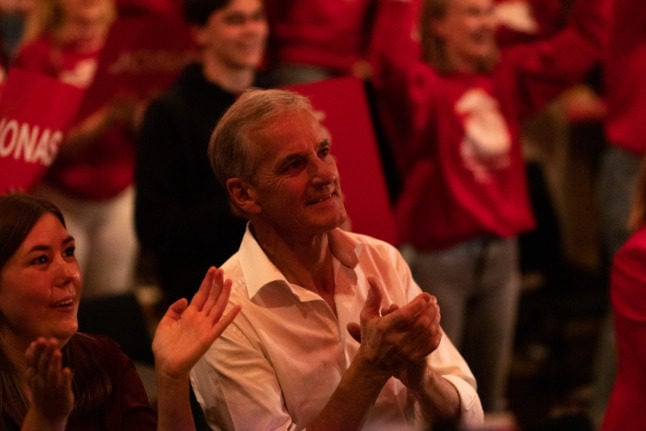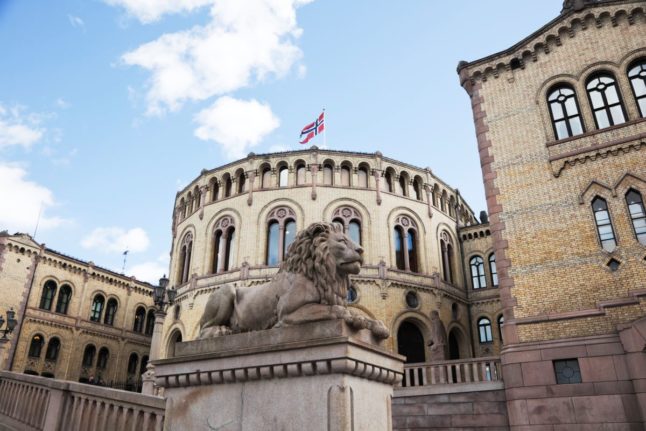100: This is the number of seats won by Norway’s five opposition parties on the night to secure a victory over Erna Solberg’s centre-right government. Norway’s parliament consists of 169 seats, and 85 is needed for a majority.
The overall result didn’t come as too much of a shock as commentators and pollsters had predicted a change of government in the long runup to the election.
89: The number of seats Norway’s most likely coalition have secured between them. This potential government is comprised of the Labour Party, the Centre Party and the Socialist Left Party.
This combination was Labour’s dream combination ahead of the election. Still, the Centre Party have insisted they aren’t too thrilled about being in government with the Socialist Left Party despite their ambition to be in a majority government with just themselves and Labour being dead in the water since the summer.
Norway, 99.5% of the vote counted:
Ap-S&D: 48 (-1)
H-EPP: 36 (-9)
Sp~RE: 28 (+9)
FrP~ECR: 21 (-6)
SV~LEFT: 13 (+2)
R~LEFT: 8 (+7)
V-RE: 8
MDG-G/EFA: 3 (+2)
KrF-EPP: 3 (-5)
PF-*: 1 (new)+/- vs. 2017 election#valg2021
➤ https://t.co/Df7Nsbqbrl pic.twitter.com/QJhlZtKKGw— Europe Elects (@EuropeElects) September 14, 2021
8: Last night’s result ends eight years of right of centre rule lead by Erna Solberg and the Conservative Party.
Solberg’s government was always up against it to get reelected, and last night, Norway’s outgoing PM admitted that she knew the Conservatives would have needed a miracle to stand any chance of staying in power.
As it happened: ‘We did it’ – Norway’s left-wing opposition triumphs in general election
4.7: That’s the historical share of the vote that the Red Party managed to grab last night. The party had never managed to meet Norway’s election threshold of four percent before. Parties that meet the threshold are awarded extra seats in parliament.
The Red Party will have eight MPs representing them in parliament.
76.5: This is the percentage of the electorate who voted in last nights election. While this turnout may seem high, it’s lower than the 2017 election, when 78.2 percent of the voters headed to the polls.
Even though voting in Norway isn’t compulsory, turnout has only been lower on four occasions.
The 1945, 1993, 2001 and 2009 elections are the only times that turnout has been lower.
1.6 million: This is how many people voted in advance in this years election, a record number and more than 50 percent of those who hit the ballot box in total.
10: Ten parties will be represented in Norway’s next parliament. These are the Labour Party, Conservative Party, Progress Party, Liberal Party, Christian Democratic Party, Green Party, Socialist Left Party, Red Party and Patient Focus Party.
1: Protest party the Patient Focus Party managed to grab one seat in Norway’s next parliament. The only non-mainstream party to do so.
The party from Finnmark, northern Norway, are focused on raising awareness of the lack of healthcare provisions available in the remote parts of northern Norway.
76: This is the number of women who have been elected to parliament this year. This equates to around 45 percent of all MPs.
The Red Party (62.5 percent) and the Socialist Left Party (61.5 percent) are the parties with the highest proportion of women elected to parliament. Ironically enough, the Progress Party will have the lowest proportion of female MPs, with less than 10 percent of their MPs being women.
2: This is Labour’s second-worst set of election results since 1924 and worst since 2001. However, Labour won’t be bothered by this factoid, and last night’s developments continue a 94-year-long streak of finishing first in Norwegian parliamentary elections in terms of percentage of votes secured.
Norway, 99.5% of the vote counted:
Ap-S&D: 26.4% (-1.0)
H-EPP: 20.5% (-4.6)
Sp~RE: 13.6% (+3.3)
FrP~ECR: 11.7% (-3.5)
SV~LEFT: 7.5% (+1.4)
R~LEFT: 4.7% (+3)
V-RE: 4.5% (+0.1)
MDG-G/EFA: 3.8% (+0.6)
KrF-EPP: 3.8% (+0.6)+/- vs. 2017 election#valg2021
➤ https://t.co/Df7Nsbqbrl pic.twitter.com/JnRziVLlPk— Europe Elects (@EuropeElects) September 14, 2021
68: This, for now, is the size of the opposition to Norway’s next government. It could rise to 69 if the Patient Focus Party decides to oppose the government.
4: The percentage of the votes that four parties battled it out to secure so they could meet Norway’s election threshold and secure levelling seats awarded to parties that achieve a decent share of support nationwide.
It was celebrations for the Red Party and Liberals who met the threshold, grabbing four and five levelling seats each and commiserations for the Green Party and Christian Democrats who fell short.
36: Jonas Gahr Støre will be Norway’s 36th prime minister since 1873 and first Labour prime minister for eight years.
Election: Who is Jonas Gahr Store, Norway’s likely new prime minister?
9: Erna Solberg will be bitterly disappointed to have lost last night’s election, albeit not entirely shocked. However, there is the small consolation of becoming the first MP to be elected to parliament for the ninth time in over 100 years.
The Bergen native has been an MP since 1989.



 Please whitelist us to continue reading.
Please whitelist us to continue reading.
Member comments